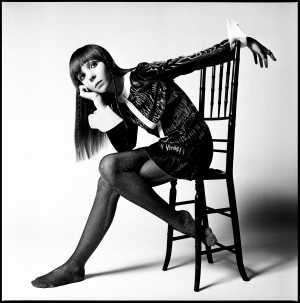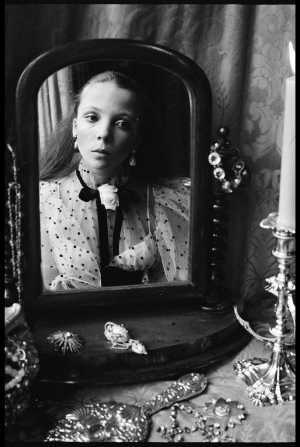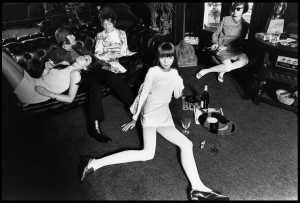Penelope Tree is asking whether I travel much for work. A fair bit, I tell her. I went to Cairo earlier this year. That was cool. Presumably she’s been to Cairo?
Oh yes, she says, I’ve been to Cairo. She was there for a Vogue shoot in 1970, with David Bailey and Jean Shrimpton. They rode Arabian horses across the desert from the Giza pyramids to the pyramids at Saqqara. Apparently, Jean Shrimpton is a brilliant horse rider; Penelope not so much. She had a thrilling time regardless.
It’s classic Penelope Tree: self-deprecating, generous to others and impossibly cool without trying to be. She shares the anecdote at the end of a long conversation over tea at the Langham Hotel. Aged 74, she retains the beauty and grace that made her one of the most celebrated models of the 1960s. Approaching the table, she doesn’t walk so much as flow.
She was born in 1949 to an American socialite and a Conservative MP. As a teenager, she attended Truman Capote’s legendary 1966 black and white ball at the Plaza and became a sensation overnight. Richard Avedon photographed her. David Bailey photographed her, romanced her and fell in love with her; the couple were together for several years. Acne curtailed her modelling career and she was arrested for cocaine possession. After breaking up with Bailey in 1974, she travelled the world, married a Beach Boy, had two children, found Buddhism, and now she’s written her debut novel, Piece Of My Heart.
The novel is heavily autobiographical, which isn’t an issue when you consider her biography. The narrator Ari escapes a wealthy but repressed childhood to elope with the notorious photographer Bill Ramsey and become a successful model at the height of the 1960s. I enjoyed it immensely. “I’m so glad,” says Tree. “I wasn’t sure if it would appeal to men.” It has drugs, sex and a cameo by the Kray Twins. What’s not to like?
The book had a long gestation period. She started on it more than a decade ago, newly single after a long-term relationship, living alone in the Sussex countryside. Writing a book was a lifelong ambition and now she no longer had any excuses. “I sort of shamed myself into writing it,” she admits. “When you get to 62, certainly when you get to 74, people start falling by the wayside; you know you don’t have forever.”
The freedom allowed by fiction appealed to her. “You can play around, you can compress time, you can make characters composite. If it was a memoir I’d have 400 people in the bloody thing.” And presumably they’d all be phoning up to denounce what she wrote about them. “Yes, exactly! How dare you, never speak to me again!” She smiles. “There might still be a little bit of that, who knows.”
How did she feel, reliving and adapting these intensely personal experiences into fiction? “It was sometimes very cathartic,” says Tree. “That’s one of the reasons why I wanted to write a book – because I felt like there were a lot of tangled threads in my memory and I could never quite get to grips with what had happened.”

Vogue model, style icon and David Bailey’s muse, Penelope Tree was the ultimate 1960s It girl.
David Bailey
I expect her mother, Marietta Peabody Tree, would be picking up the phone had she not died in 1991. Like her fictional counterpart Maud, Marietta was a remarkable woman and a lousy mother. Penelope recalls the admiration her mother would provoke in people: “She’s beautiful. She was also highly intelligent, highly capable and worked so hard. But she lacked any maternal instinct. OK, you can’t have it all, but it wasn’t right for her kids.”
Asked to predict her future, a teenage Marietta quipped: “Parties, people and politics.” She became a famed Manhattan socialite and served in the Kennedy administration; her lovers included the film director John Huston and two-time Democratic presidential nominee Adlai Stevenson. Motherhood was a box to be ticked off; children were viewed as “a necessary but rather annoying impediment to your life”, and handed over to the nearest nanny. The nannies did a decent job: Marietta’s eldest daughter, and Penelope’s half-sister, Frances FitzGerald is a celebrated journalist who won the 1973 Pulitzer Prize for her book on the Vietnam War.
Penelope’s father Ronald was Marietta’s second husband, a Conservative MP who lost his seat in the 1945 General Election. The family lived in Oxfordshire before a bored Marietta convinced Ronald to sell their country estate and move to Manhattan, children and butler in tow. Ronald was a good man who concealed his bisexuality from Penelope all his life; there is a beautiful scene in the novel where Ari discovers her father listening to records with his secret lover and quietly leaves them in peace.
The Tree townhouse on the Upper East Side was quite the social hub; Truman Capote came for lunch and changed the teenage Penelope’s life. “I heard his voice across the room and it was totally shocking because he was very camp and he had a lisp,” says Tree, noting that camp wasn’t common in 1962. She approached the writer as everybody was going into lunch and expressed her admiration of his work.
“Do you write?” inquired Truman Capote. (Reconstructing this encounter at the Langham more than 60 years later, Tree adopts a lisping drawl.) Yes, she did. “Send me your stories,” said Capote. Teenager and author struck up a correspondence. “I cringe to think of it,” says Tree, “but he sent me little notes saying, ‘Keep on going. Talent doesn’t mean anything if you don’t write every day.’”

Penelope Tree & The Wigwam, 1970 shot by David Bailey
David Bailey
In 1966, Capote published In Cold Blood and attained a new stratosphere of celebrity. He decided to throw a party, not just any party but a black and white masked ball whose invitation would be more coveted than a winning lottery ticket. The guestlist featured the cream of Hollywood, Manhattan, Washington – and a teenage Penelope Tree, the youngest of 540 attendees. “It wasn’t really fun,” recalls Tree. “Nobody talked to me because I was 16.”
She made an impression nonetheless. In her 2007 book Party of the Century, author Deborah Davis wrote: “The smash-hit of the evening, though, was the ingénue Penelope Tree. More naked than dressed in her flowing black tunic and form-fitting tights, Tree caught the eye of every person in the room. Even the CBS camera lingered on her narrow, exposed midriff, as if entranced… Her entrance signalled the presence of a new generation at the ball. Tree was discovered by the fashion world that night. Cecil Beaton and Richard Avedon were so enchanted by her unspoiled beauty that they conspired on the spot to turn her into a cover girl – which she soon became.”
Very soon: 9am the next morning, Penelope received a phone call from a woman saying that Avedon wanted to shoot her for a magazine. The magazine was Vogue and the female caller was Diana Vreeland, its legendary editor. Notably, Vreeland is the only major character in the novel to appear as themselves. “She was wonderful,” sighs Tree. “I couldn’t make her any other way. She just was the most wonderful company and inspiring person.”
Although she had been photographed as a child by Diane Arbus, her work with Avedon was Tree’s first professional shoot. Surprisingly, David Bailey would later state in his autobiography Look Again that Avedon’s were the best pictures ever taken of Penelope. “It was very generous of him!” says Tree when I bring this up.
Does she agree with this assessment? “Yeah,” she says after a momentary pause. “It was my first experience of working and we had this connection which was not based on romance or sex or anything like that. Something happens for the model as well as the photographer; you can have a moment where you suddenly connect and it’s like dancing or something. It’s like on another plane, almost, another dimension. We’re living there and it’s very liberating.” That’s a beautiful description, I tell her. “It’s true!”

Tree photographed by David Bailey’s son Fenton in May 2024.
Fenton Bailey
The connection with Avedon might have been chaste; the connection with David Bailey was anything but. Photographer and model met in 1967 on a Vogue shoot. The womanising Bailey was dating the model Sue Murray and married to the actress Catherine Deneuve but he and Tree were soon head over heels. “There was something instant between us,” claimed Bailey of his first shoot with Tree. “It was obvious to us both. I realised I had fallen in love with her pretty quickly.” Theirs was a romance foretold – by none other than Deneuve who saw photos of Tree in Vogue and told her husband, “You’re going to go off with that girl!”
Go off with her, he did. The couple consummated their relationship in Paris, January 1968. He was her first. During their Parisian sojourn, she lost her winter coat and didn’t bother to buy a replacement. She had no need of one, being so flushed with passion and happiness.
If you want an idea of the experience, consider the following lines from Piece of My Heart after Ari first sleeps with Bill Ramsey in the French capital: “The next few days were infused with a sense of soaring elevation and extraordinary beauty. I remember shafts of winter sunlight falling across our bed, the deserted arcades, winter trees in the Jardin de Luxembourg; every sound, every sight, every taste we shared was subsumed in bliss… We ordered meals in restaurants we couldn’t eat, kissed in the back of cinemas and missed the films we wanted to see; we trawled the jazz clubs in the early hours drinking calvados.”
Reading those words, my initial reaction was envy… “That’s what my children say to me, too,” smiles Tree. “‘You’re so lucky as you have lived through that time!’ But of course it’s never quite what you think. It’s not like the image. You’re always living on the inside, going through your own neurosis or your own experience of life, which is never quite the same as you think from the outside.”
Fair point, but isn’t whirlwind romance always great? Even if it isn’t experienced in 1968 Paris but, say, 1937 Slough or 2024 Weston-super-Mare. “No, it was a wonderful experience,” concedes Tree. “It really was. And I won’t knock it. I just think maybe falling in love to that extent is quite dangerous as well.” Hard to stop though… “No, nothing in the world would have stopped it. Nothing, nothing, nothing.”
In the spring of 1968, Bailey went to the Tree family home in Manhattan to bring Penelope back to London with him. Usually the butler answered the front door but on that occasion it was opened by Marietta and she promptly tried to shut it in his face. “It could be worse,” said Bailey, getting his foot in the way. “I could be a Rolling Stone.”
Whereas Bailey and Ronald got on well, he had a fraught relationship with Marietta – the swaggering Cockney and aristocratic Manhattan socialite often clashed in their infrequent encounters. There’s an excruciating scene in the novel where Maude insults Bill Ramsey and he responds by calling her a cunt. “That was based on real life,” confirms Tree. “I can’t say it was exactly the same, but it was very similar.” She describes the exchange as “appalling, cringe making,” before noting, “One of the reasons I was with Bailey is because he stood up to my mother. I loved him for that.”

Tree shot for Vogue in Oxford, 1968.
David Bailey
She returned with Bailey to his Primrose Hill flat and became one of the most sought-after models in the industry. Her unique look – described by Bailey as “a mixture of an Egyptian Jiminy Cricket and Bambi” – adorned the pages of numerous fashion magazines. They travelled the world together: Paris, New York, Rome, India, Turkey, Zambia, Egypt. For the further flung shoots, it was typically a team of four: Bailey, his assistant John Swannell, Tree and a fashion editor.
Her favourite memory of those times? A road trip from London to Rome in Bailey’s Ferrari 275 GTB/4. She can’t recall the exact date but it was the cusp of summer and the weather was beautiful. They played Miles Davis’ Sketches of Spain in the car and stayed in little towns and villages rather than luxury hotels. “We hardly said a word to each other but we were as one. That was great. That’s what I remember.”
They shared the flat with 60 parrots (Bailey loved parrots), two dogs and numerous gold-framed photographs of Bailey’s past girlfriends. Tree recruited a Brazilian helper named Cesar who acted as a butler, albeit a far more insouciant one than her parents would have ever employed. (According to Bailey, Cesar never cleared up and would often bring a guest a drink and sit down next to them.)
When the couple weren’t travelling, their flat became the venue of a perpetual party. Celebrities, creatives, advertising executives, bohemians – half of London ended up on the sofa. Despite her youth, Penelope’s upbringing made her a peerless hostess. John Lennon famously described her as “hot, hot, hot; smart, smart, smart” – which is funny, she says, because she never spent much time with him. She was much better friends with George Harrison.
Photographer Cecil Beaton was another visitor. He had danced with Penelope at Capote’s ball – now Bailey was making a documentary about him. Beaton described Penelope in his diaries as “subtle, sensitive and highly intelligent”; he was less enamoured with the “cocky Cockney” Bailey and the condition of the flat. “God what a shock this ménage must be to the Tree parents. I feel acutely sorry for them” wrote Beaton. “Boy, was he a neat freak!” says Tree when I bring this up.
A precocious teenager is still a teenager and Tree struggled with multiple insecurities. Her lifelong clumsiness – “I’d walk into the room and things would start falling over” – accentuated when she was with Bailey. She once fell off a rowing boat in Central Park during a shoot. “The relationship between me and Bailey grew quite fraught when we started working together,” says Tree. “I would resist his directions and we’d get into this argument and then I’d fall into the water.”
She was jealous of other women, most of whom she suspected of having their eye on her boyfriend, many of whom probably did. As early as May 1968, the couple drove through Paris in the grip of such a ferocious row that they didn’t notice the ongoing student riots. “Students running down the street, sliding off barricades, bombs, and we just drove through the whole thing as we were arguing and completely missed it.”

David Bailey
Her health began to suffer, mental and physical. “I was anorexic at boarding school,” says Tree. “I got rewarded for that by becoming a model.” By her early twenties she was also bulimic. Most damaging for her career was a severe case of late-onset acne, caused by hormonal balance from her anorexia and quite possibly stress. Her relationship with Bailey was beginning to fall apart. “I was so angry and upset but I couldn’t express it. I had no means to express anything serious. It was all swept under the carpet so it came out in my face.”
I wonder if therapy would have helped… Tree laughs. “A bit of therapy could have been a good thing!” What about friends? “I couldn’t talk to anybody. I was so uptight. I could socialise and all of that but I couldn’t talk about what was actually going on.” A result of her upbringing? “Yeah. You know how it is. My parents did the same thing.”
By 1971, her modelling career was over. The following year, she bought some cocaine at a squat from a dealer who was promptly arrested outside. “He ratted on everyone immediately.” The flying squad burst into the room and marched her to the police station. “They did not allow me to have a phone call. They were pretty shitty, actually. I was thrown into the cell for the night without any recourse and nobody knew where I was.”
Must have been a horrible comedown… “It was a comedown, but it was probably very, very good for me. I hate to say it, because they were shits, but it did kind of make me sit up and take notice of what was happening to me and be held accountable.” Her father supported her throughout the heavily publicised trial. Her lawyers claimed the loss of her modelling career affected her judgement and she got off with a conditional discharge.
She left Bailey soon afterwards. “Actually he kind of left me,” says Tree. “It’s just that I happened to be still in the house. I left him physically, but he had left me.” He was in Paris with a friend’s wife; Penelope packed her bags and departed. In Bailey’s autobiography, he reunites with Tree for a conversation some 50 years after their relationship. He claims that he tried to get her back… “He says he did. It’s just total bullshit,” says Tree in a mixture of affection and exasperation. “I kept saying to him, how come I didn’t hear about it if you were trying to get me back?”
Whatever the truth, she never did go back – to modelling or to Bailey. Still not 25, she started her life all over again.
View on Instagram
Naturally, Penelope Tree processed her breakup in the coolest way imaginable. After leaving Primrose Hill, she briefly lodged in a valet room at the top of the Ritz (there was no valet in situ) before flying to Barbados to stay with her father. There, something extraordinary happened to her.
“I was sitting on the beach one day, thinking my life is over. Out of the corner of my eyes, I saw a sailboat, tacking across the horizon. They anchored in the sea, right outside the house, two guys and a girl dressed in Moroccan gear and looking like hippies. They came up to me and said, ‘Do you know where we can get something to eat? We’ve just sailed across the Atlantic from Morocco.’ I took them home. We had dinner and I got on the boat and I sailed with them for six months.”
Where did they sail? “Down the Dutch Antilles, the coast of Venezuela, Columbia, Panama. It was amazing. And I didn’t know how to sail before.” She now lived solely in the present. During their voyage, the boat sailed into a terrible storm that lasted two, three days – yet weirdly Penelope wasn’t afraid. “They were so impressed that I wasn’t afraid that somehow I earned my stripes.” Who were these nautical hippies? “I can’t go into their names but they were extraordinary people and still are.”
She continued to travel the world. Met the musician Ricky Fataar and moved to Sydney with him. They had a daughter; she also has a son from her second marriage. In the 1980s, she discovered Buddhism after a chance encounter with the Dalai Lama. One of her friends had a ticket to see His Holiness speak but was too sick with AIDS to attend. She offered Tree the ticket in her place, a front row seat in a huge cathedral. Tree can take up the story.
“He came off the stage and he shook hands with everybody in the front row. I had this extraordinary experience where I felt this deep connection with him and I realised that he was the real deal. He wasn’t pretending to be a holy person, he was just a human being who happens to have some extraordinary consciousness – or maybe awareness is the word.”
She volunteered for Lotus Outreach and the Khyentse Foundation; the former helping children in southeast Asia, the latter promoting Buddhism around the world. Ended up in Sussex and started to write a book. She and Bailey remain close; the photographer is 86 now and living with vascular dementia. It’s unlikely he’ll read her book, but in his, Tree was described as one of the three great loves of his life, along with Jean Shrimpton and his present wife Catherine Dyer. “She’s much better than I would ever have been,” says Tree. “He found the best person for him. She’s great.”
The day after our interview, I attend the launch of Piece of My Heart. Penelope’s son is there, along with Michael Palin and a whole host of people clearly in the middle of some fascinating lives. She signs hardback books and makes a short but typically elegant speech that includes a poignant shoutout. “Thank you to David Bailey, who allowed me to create the cover art from our first shoot together. You are my first love and I’ll always love you.”
Beautiful words to end upon – but there’s always been far more to Penelope Tree than beauty. A better epitaph might be the opening lyrics to Janis Joplin’s ‘Piece of My Heart’, the track that gave the book its title.
‘Didn’t I make you feel like you were the only man? / Yeah and didn’t I give you nearly everything that a woman possibly can? / Honey, you know I did / And each time I tell myself that I, well I think I’ve had enough / But I’m gonna show you, baby, that a woman can be tough…’
'Piece of My Heart' is out now.

